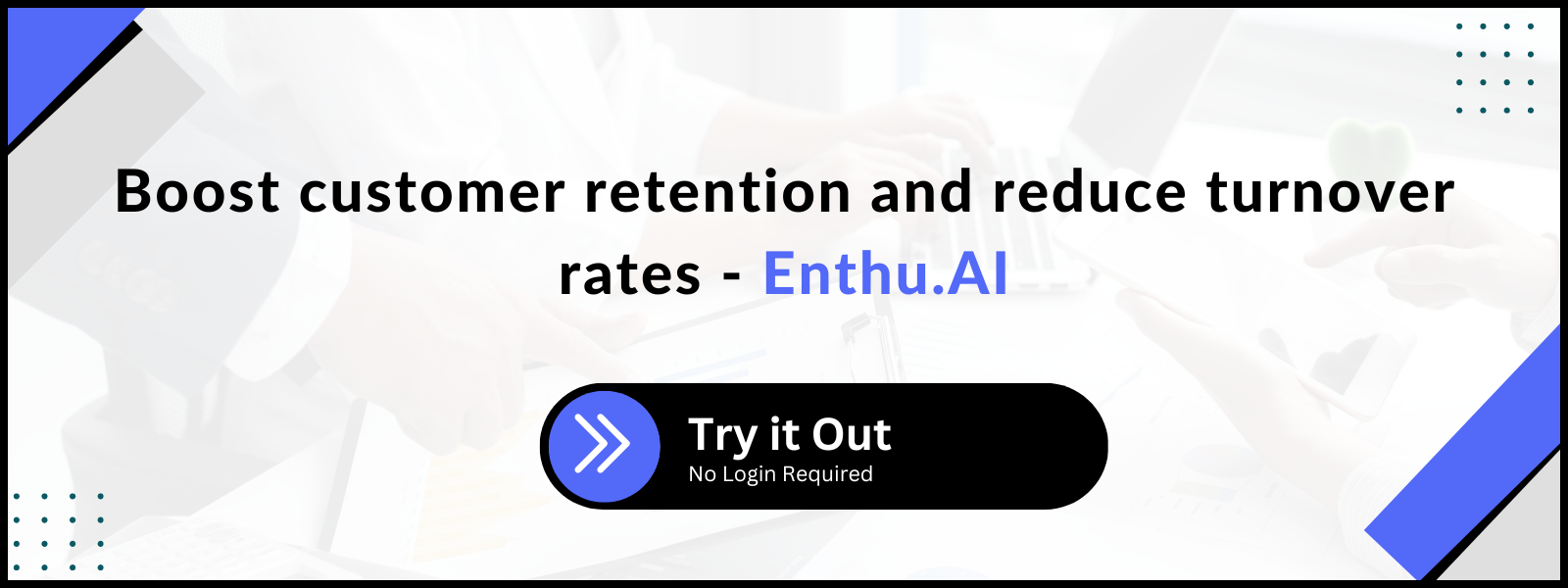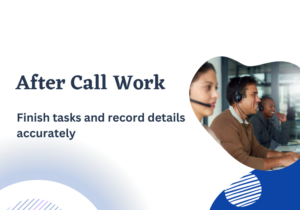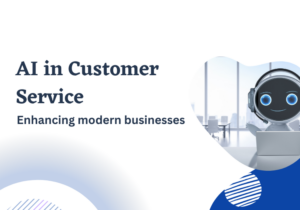In today’s competitive business landscape, customer churn rate has become a key performance indicator for businesses of all sizes.
It is an important metric because losing customers can have a significant impact on a business’s revenue and growth.
The average churn rate across all industries is approximately 5%. However, this number varies significantly depending on the industry and business model.
In this blog, we will understand the meaning of customer churn rate also known as customer attrition.
A. What is customer churn?
Customer churn is the percentage of the customers that has stopped using the company’s product or service during a certain time frame.
It is usually expressed as a percentage of the total number of customers at the beginning of that period.
To calculate churn rate, you need to divide the number of customers you lost during that time period by the number of customers you had at the beginning of that time period.
For example, if the number of customers is 400 at the start of the time period, and the end of that period it is 360, the churn rate will be 10%.
You can also calculate churn rate in one of the following ways:
a.Total number of customers lost during a specific period
- Percentage of customers lost during a specific period
- Value of recurring business lost
- Percentage of recurring value lost
(churned customers / total customers) * 100
Anyways, investing in a good call monitoring software provides valuable insights into why customers may be churning.
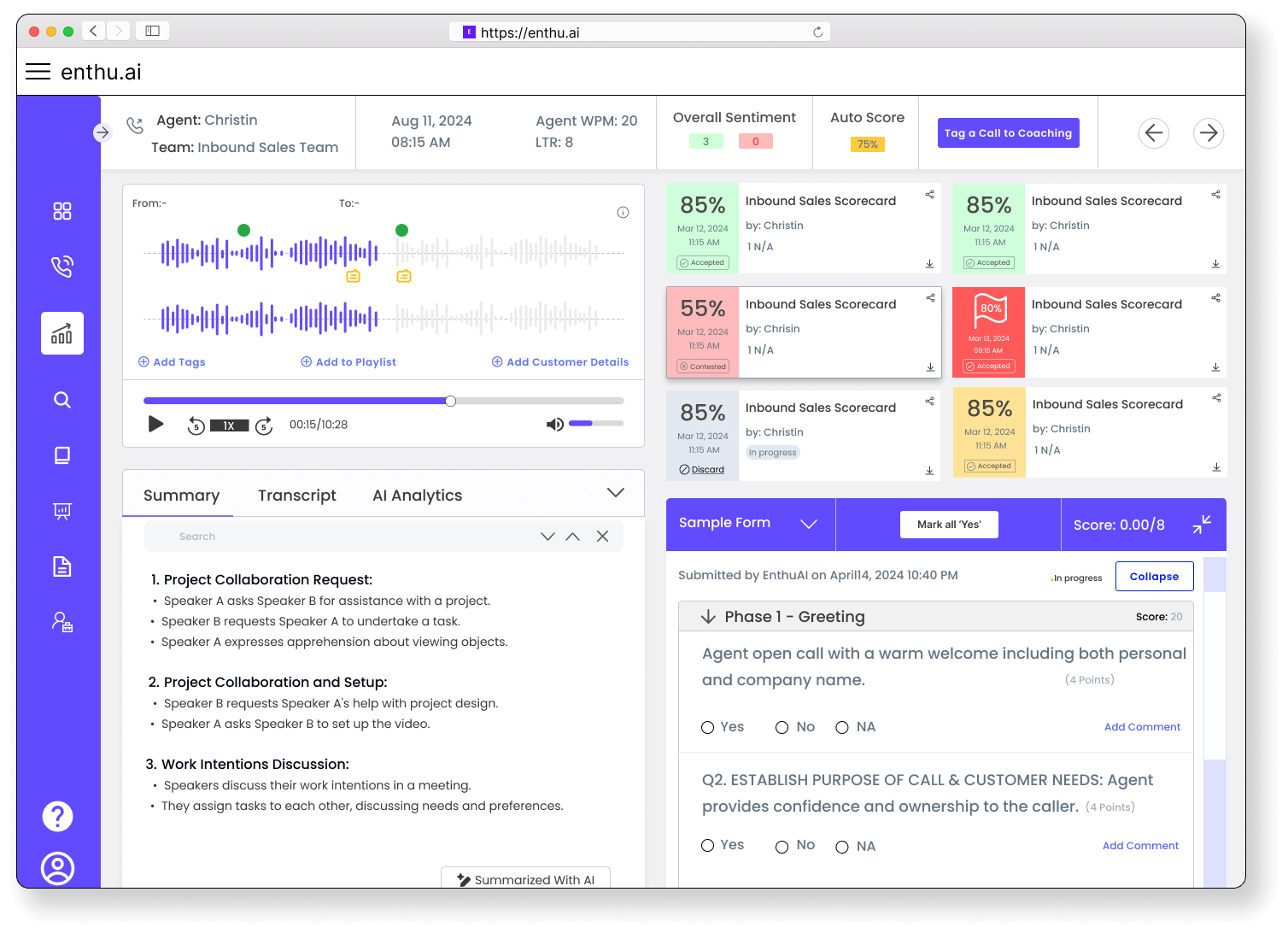
By monitoring calls, companies identifies common issues that leads to dissatisfaction and hence reduce customer churn.
Enthu.AI is one such solution that helps you analyse areas where agent needs additional training or coaching, and uncover the trends that leads to customer churn.
By addressing these issues, companies can improve their customer service and reduce churn.
B. Good and bad customer churn rate.
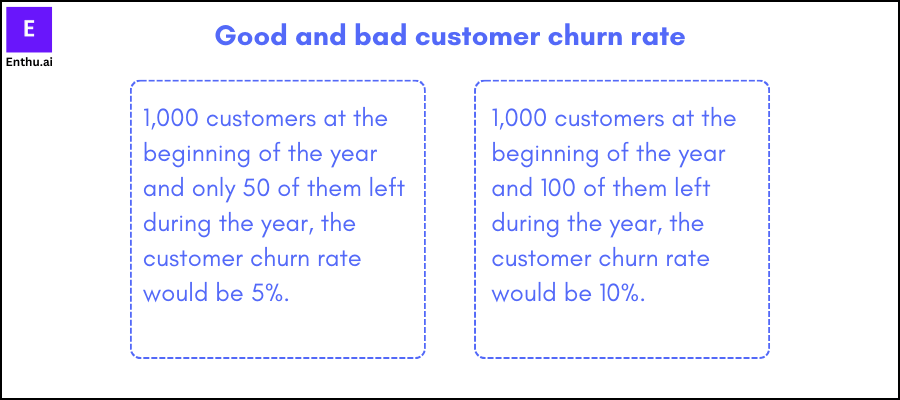
1. Good customer churn rate
A good customer churn rate would be below 5% per year.
For example, if a company had 1,000 customers at the beginning of the year and only 50 of them left during the year, the customer churn rate would be 5%.
This indicates that the company is retaining a high percentage of its customers and that customer satisfaction is likely high.
2. Bad customer churn rate
On the other hand, a bad customer churn rate would be above 5% per year.
For example, if a company had 1,000 customers at the beginning of the year and 100 of them left during the year, the customer churn rate would be 10%.
It’s important to keep in mind that the customer churn rate can vary by industry and that a customer churn rate of 5% may be considered good for one company but bad for another.
Additionally, a higher customer churn rate may be acceptable for businesses with high customer acquisition costs, as they can still be profitable if they acquire new customers faster than they are losing them.
But no matter what your industry metric or sales statistics are business should focus on techniques and ways to reduce customer churn rate.
C. Why is customer churn rate important?
Knowing reduce customer churn rate is important because a high rate leads to decrease in revenue.
When customers leave your company, they take away their revenue as well with them.
If you convince them to stay, then you can increase the revenue for your firm because they will spend 67% more on your company’s products and services.
It’s important to note that the customer churn rate can help you understand the health of your business,
but it’s just one metric, and you should also consider other metrics like customer satisfaction and customer lifetime value when evaluating the success of your company.
D. Reasons for customer churn

1. Bad customer service
Providing bad customer service is one of the main reasons behind customers opting out of the company.
Even an informed customer can run into problems with the product or service they are using.
It needs to be resolved as soon as possible because otherwise, customers will start looking for replacement options.
In this situation, customers might not want to go through the knowledge base or interact with bots.
They need to talk to real people who can solve the problem instantly.
Therefore, a great customer service can help you reduce customer churn.
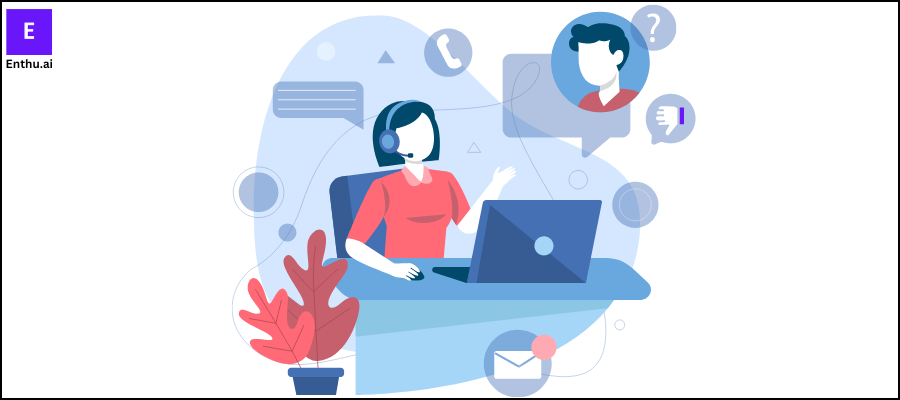
2. Difficult user experience
While using the product or service, customers want to have seamless experience.
Customers are using your product or service for their business and when they encounter bugs and glitches, companies lose productivity and revenue.
Therefore, companies need to provide the best user experience.
If companies fail to do so, customers tend to find other companies who provide similar service or product.
3. Sold to wrong people
Companies tend to sell their products or services to people who never really want the product or service.
After using the product for some time, they understand that they do not need the product or service and they opt-out of the deal.
It is a major reason for customer churn. So, it is always better to bring in clients that really need your product or service.
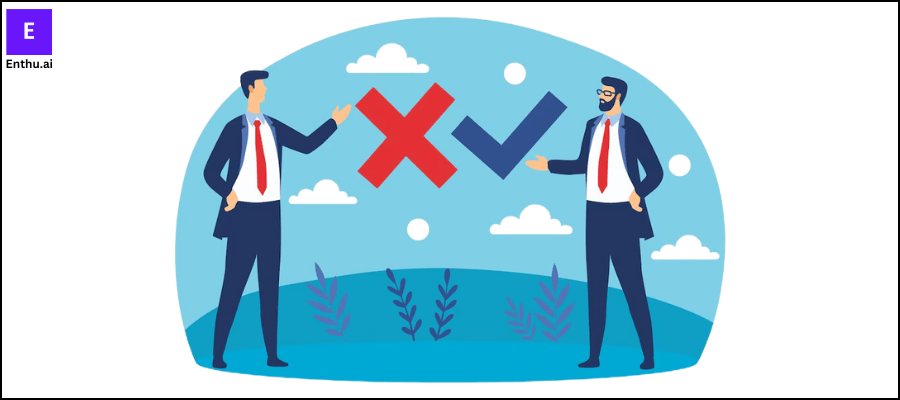
4. Bad on-boarding process
One reason for reduce customer churn is a bad on-boarding process.
When customers buy your product, it is your duty that you help the customers to understand the product completely.
When that doesn’t happen, it becomes difficult for the customers to be able to use all the features of the product.
And as a result, they will stop using the product because they are not able to see the value of the product.
To encounter this, you need to provide full support to the customers through the entire onboarding process.
You need to make sure that they understand how to use the product efficiently.
E. 10 Ways to reduce customer churn?
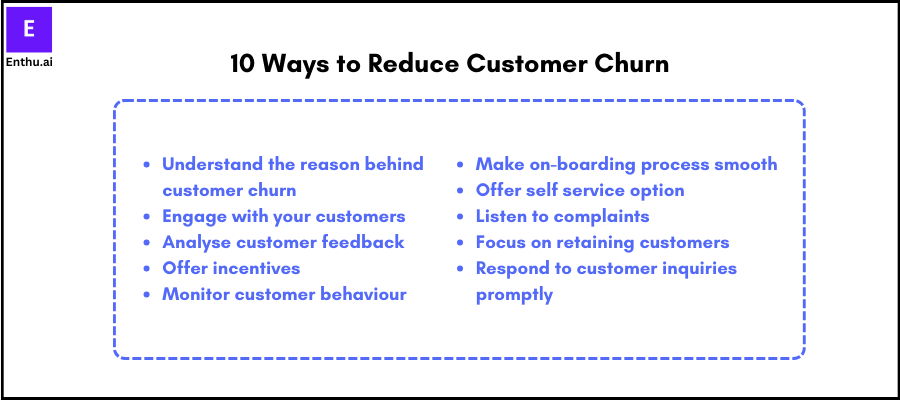
Reducing customer churn rate is crucial for maintaining and growing a successful business.
A high churn percentage indicates that a significant number of customers are leaving and can have a negative impact on revenue and customer acquisition costs.
Here are some ways to help you reduce customer churn rate:
1. Understand the reason behind customer churn
By this method, you will be able to reduce customer churn to a great extent.
You just need to pick up phone and ask the clients the reason behind not using the product anymore.
This way you are demonstrating that you care for the customers and will be able to understand the reason instantly.
When you understand the reasons, it will help you correct your mistakes and make other customers stay.
To achieve this, you need to be quick in contacting the customers and asking for feedback.
You have to be actively using all the feedback channels for that: phone, e-mail, website, live chat and social media.
2. Engage with your customers
Make sure that customers are actively using your product.
You have to make the customers realize the value of your product so that they begin to use the product on the daily basis.
Start by writing enough content that shows key functional benefits of your product and provide regular updates to customers regarding new offers, upgrades and deals.
Also, you can always ask for feedback from customers.
Ask them what they like about the product and what more functions would they like in the product.
This will help you understand whether customers are taking interest in your product or not.
Ensure that your customers have a positive experience with your product or service.
Address any pain points or complaints that customers may have, and make improvements to your offerings to better meet their needs because this helps tor reduce customer churn.
3. Analyse customer feedback
When analyzing customer feedback, companies should pay attention to both positive and negative comments.
Positive feedback can provide valuable insights into what customers like about the company and can be used to reinforce those aspects of the business.
Negative feedback, on the other hand, can help companies identify areas where they are falling short and need to make improvements.
To effectively reduce customer churn analyze their feedback, companies can use a variety of tools and methods, including surveys, online reviews, and social media monitoring.
These tools can provide a wealth of data that can be analyzed to identify trends and patterns in customer feedback.
This can help companies prioritize areas for improvement and develop targeted strategies to address customer concerns.
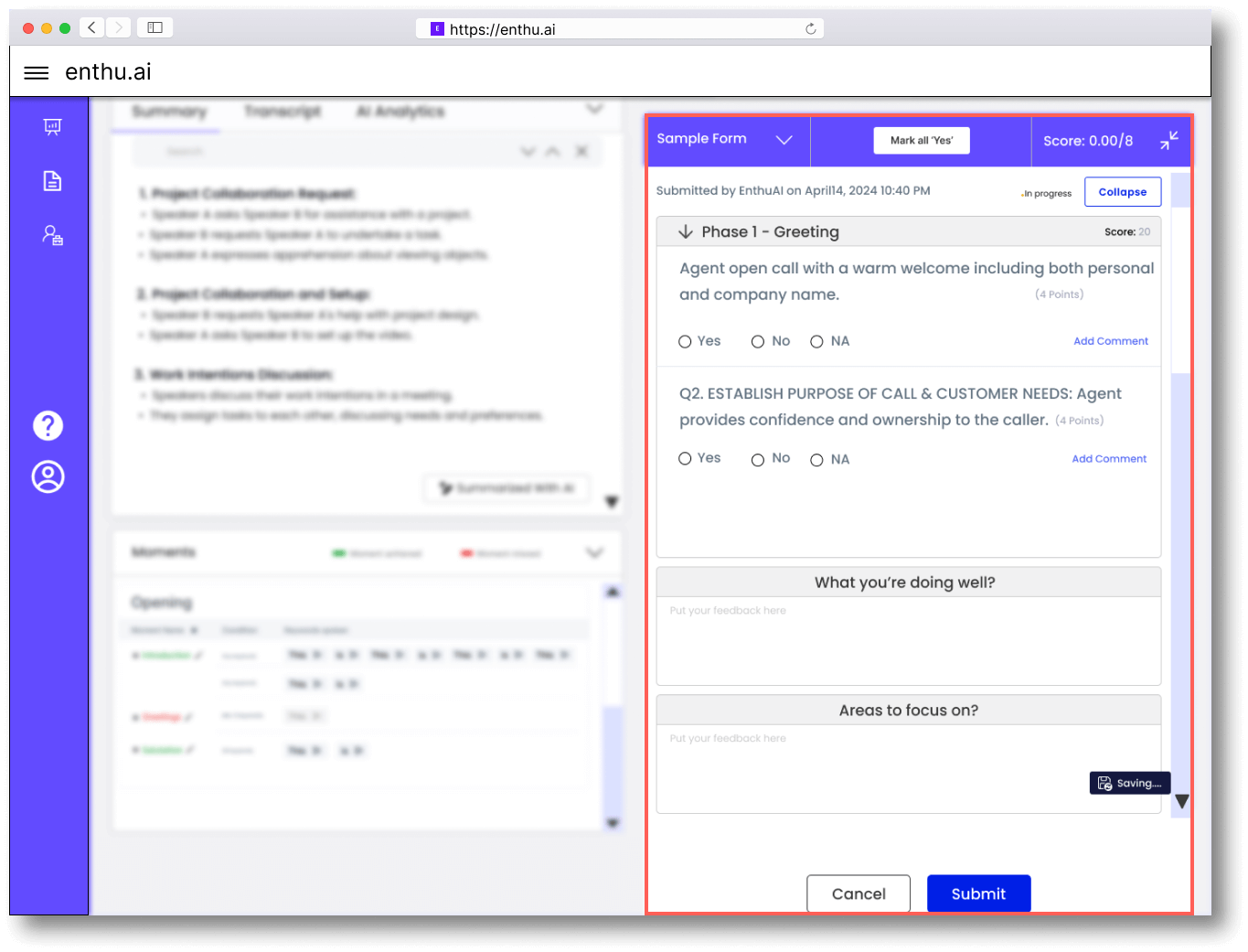
4. Offer incentives
You need to provide offers and discounts to those customers who are likely to leave your product or service.
This is considered as one of the best tactic to reduce customer churn.
But make sure that you are offering incentives to only those customers that will bring in revenue for the firm, i.e, the cost of retaining the customers is always less than the profits you will be earning from that customer.
Do not waste your money on the customers that will not bring in the substantial revenue for the firm.
5. Monitor customer Behaviour
By tracking how customers interact with a business, companies can identify potential issues, predict churn, and take proactive steps to retain customers.
One of the primary benefits of monitoring customer behavior is the ability to identify patterns and trends.
By analyzing customer data, companies can reduce customer churn and determine which customers are at the highest risk of churning and develop targeted retention strategies to keep them engaged.
‘For example, if a customer has not made a purchase in several months, a company could send them a personalized email offering a special discount or promotion to encourage them to make a purchase.’
Monitoring customer behavior can also help companies identify areas where they need to improve.
For example, if customers are consistently abandoning their shopping carts during the checkout process, a company could investigate and address any issues with the checkout process that may be causing frustration or confusion for customers.
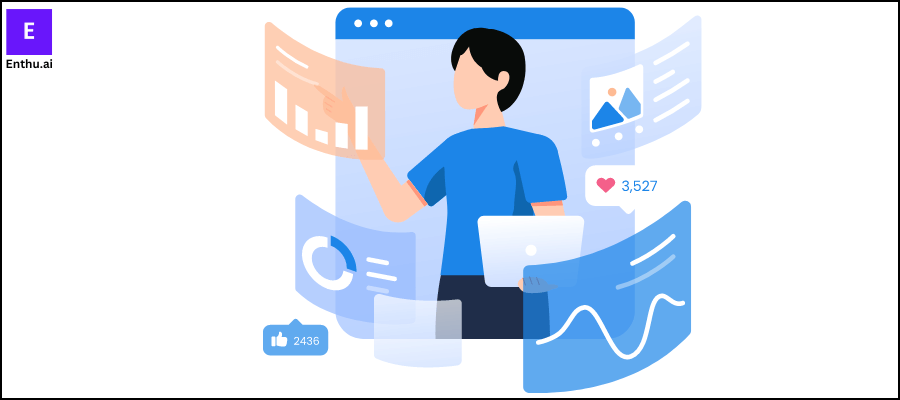
6. Make on-boarding process smooth
Make the on-boarding process smooth for the new customers, i.e., they must know how to use the product effectively and efficiently.
Because it can be overwhelming for new customers to start with new product or service.
If you fail to do so, you will see customers will start leaving your product.
This is one of the most important technique to reduce customer churn.
To not let that happen, you must set up a new on-boarding process that will make customers understand product’s features, functionality, and process.
Through this process, you need to make sure that customers see the value of your product for them and and if it happens, they will less likely to leave your product.
So, constantly keep an eye on the on-boarding process and look out for snags or blockers.
7. Offer self service option
To effectively offer self-service options, companies must invest in the technology and resources necessary to provide a seamless experience.
This can include developing a user-friendly chatbot interface or creating a comprehensive FAQ page that is regularly updated and maintained.
By providing high-quality self-service options, companies can reduce the workload of their support teams and provide customers with the tools they need to solve their own problems.
This way businesses can reduce customer churn rate and ultimately leads to improved customer satisfaction, and increased loyalty and engagement.

8. Listen to complaints
When you listen to your customer complaints and make it a priority to solve them, then it reflects that you care for the customers.
It is important to solve customer issues because it takes one negative experience to make 61% of the customers stop doing business with the firm.
Also, when you solve issues of the unhappy customers, it is likely that they will become loyal to your firm and will even advocate for the product.
Regularly check in with customers to get feedback on their experience.
Respond to their concerns and suggestions in a timely and appropriate manner to show that you value their opinions which in return reduce customer churn rate.
You can even record your agents – customer conversation to analyse whether the issue was solved or not.
9. Focus on retaining customers
When a company can keep its existing customers, it reduces the need to spend more resources on acquiring new customers.
This is because it is more cost-effective to retain existing customers than to acquire new ones.
Existing customers have already shown interest in the company’s products or services, and building a relationship with them can lead to increased trust and loyalty.
Customers who stay with a company for a long time become more valuable over time.
As they become familiar with the company’s products or services, they may be willing to spend more on them or purchase higher-priced products.
This can lead to increased profitability and a stronger bottom line for the company.

10. Respond to customer inquiries promptly
One of the best way to reduce customer churn is quickly solving their issues and inquiries.
When customers reach out with questions or concerns, they want a timely response and a resolution to their issue.
90% of customers rate an “immediate” response as important or very important when they have a customer service question.
This highlights the importance of responding to customer inquiries as quickly as possible to meet their expectations and prevent them from seeking out competitors.
By implementing these strategies, you can the foster voice of customer, reduce customer churn rate, and improve customer experience.
Remember that reducing customer churn rate is an ongoing process that requires continuous improvement and monitoring.
Conclusion
Having new customers is good but retaining customers is even better for the company.
You have to make sure that customers understand the value of your product and realise that it is better to stay with your product rather than leave your product.
Also, it is good for financials because retaining a customer is less costlier than acquiring a new customer.
To reduce customer churn, all it takes is to understand the reasons behind the churn and act on them.
Provide best customer service and have a clear communication with customers.
FAQ
1. How to save a customer from churning?
- Provide personalized engagement
- Address their concerns proactively
- Offer tailored solutions
- Ensure exceptional customer service
- Enhance satisfaction and loyalty
2. What is the meaning of customer churn?
Customer churn, also known as customer attrition, refers to the loss of customers over a given period. It is typically measured as a percentage of customers who discontinue their relationship with a company, service, or product. High churn rates can indicate dissatisfaction and negatively impact a business’s revenue and growth.
3. How can customers improve their churn rate?
Customers can improve their churn rate by:
- Enhancing customer service and support
- Personalizing customer interactions
- Collecting and acting on customer feedback
- Offering loyalty programs and incentives
- Continuously improving product or service quality
- Providing proactive communication and problem resolution
- Implementing customer retention strategies and follow-ups

